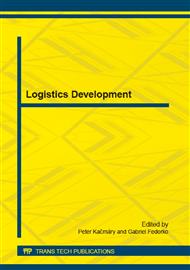[1]
A. Huttmeir, et al., Trading off between heijunka and just-in-sequence. Int. Journal of Production Economics. 118 (2009) 501-507.
DOI: 10.1016/j.ijpe.2008.12.014
Google Scholar
[2]
A. L. Bergenwall, C. Chen, R. E. White, TPS's process design in American automotive plants and its effects on the triple bottom line and sustainability, Int. Journal of Production Economics. 140 (2012) 374-384.
DOI: 10.1016/j.ijpe.2012.04.016
Google Scholar
[3]
M. Djassemi, The Impact of Lean Level Material Flow on Performance of Manufacturing Systems for Large Complex Parts, Production and Inventory Management Journal 46 (2010) 127-35.
Google Scholar
[4]
F. Bohnen, T. Maschek, J. Deuse, Levelling of low volume and high mix production based on a Group Technology approach, CIRP Journal of Manufacturing Science and Technology. 4 (2011) 247–251.
DOI: 10.1016/j.cirpj.2011.06.003
Google Scholar
[5]
J. K. Liker, The Toyota Way: 14 Management Principles from the World's Greatest Manufacturer, McGraw-Hill, New York, (2004).
Google Scholar
[6]
D. T. Jones, Heijunka: Levelling Production. Manufacturing Engineering. 137 (2006) 229-35.
Google Scholar
[7]
A. M. Deif, Dynamic analysis of a lean cell under uncertainty. International Journal of Production Research. 50-4 (2012) 1127-1139.
DOI: 10.1080/00207543.2011.556154
Google Scholar
[8]
S. Smith, Muda, Muri and Mura, ASQ Six Sigma Forum Magazine. 13-2 (2014) 36-37.
Google Scholar
[9]
J. Matzka, M. D. Mascolo, K. Furmans, Buffer sizing of a Heijunka Kanban system. Journal of Intell Manuf. 23 (2012) 49-60.
DOI: 10.1007/s10845-009-0317-3
Google Scholar
[10]
Productivity Press. Development Team. Quick Changeover for Operators: The SMED System, Productivity Inc., Portland, (1996).
Google Scholar
[11]
B. J. Coleman, M. R. Vaghefi, Heijunka: A key to the Toyota production system. Production and Inventory Management Journal. 35-4 (1994) 31-35.
Google Scholar
[12]
P. Marksberry, F. Badurdeen, M. A. Maginnis, An investigation of Toyota's social-technical systems in production levelling. Journal of Manufacturing Technology Management. 22-5 (2011) 604-620.
DOI: 10.1108/17410381111134464
Google Scholar
[13]
D. Holman, P. Jirsak, Unified Theoryof SCM Competitivnessin 21st century (Principles of paradigmatic change MassSCM > LeanSCM), CLC. (2013) 1-7.
Google Scholar
[14]
Z. Molnár, How write scientific paper. Information on http: /k126. fsv. cvut. cz/predmety/d26mvp/mvp_sylabus-mvp. pdf.
Google Scholar
[15]
J.P. Womack, D.T. Jones, D. Roos, The Machine that change the world, Free Press, (2007).
Google Scholar
[16]
T. Ohno, Toyota Production System: Beyond Large-Scale Production, Productivity Press, (1988).
Google Scholar
[17]
J. M. Keynes, The General Theory of Employment, Interest and Money, Palgrave Macmillan, (1936).
Google Scholar
[18]
P. F. Drucker, Management Challenges for 21st century, Harper Colins Publisher, New York, (1999).
Google Scholar


